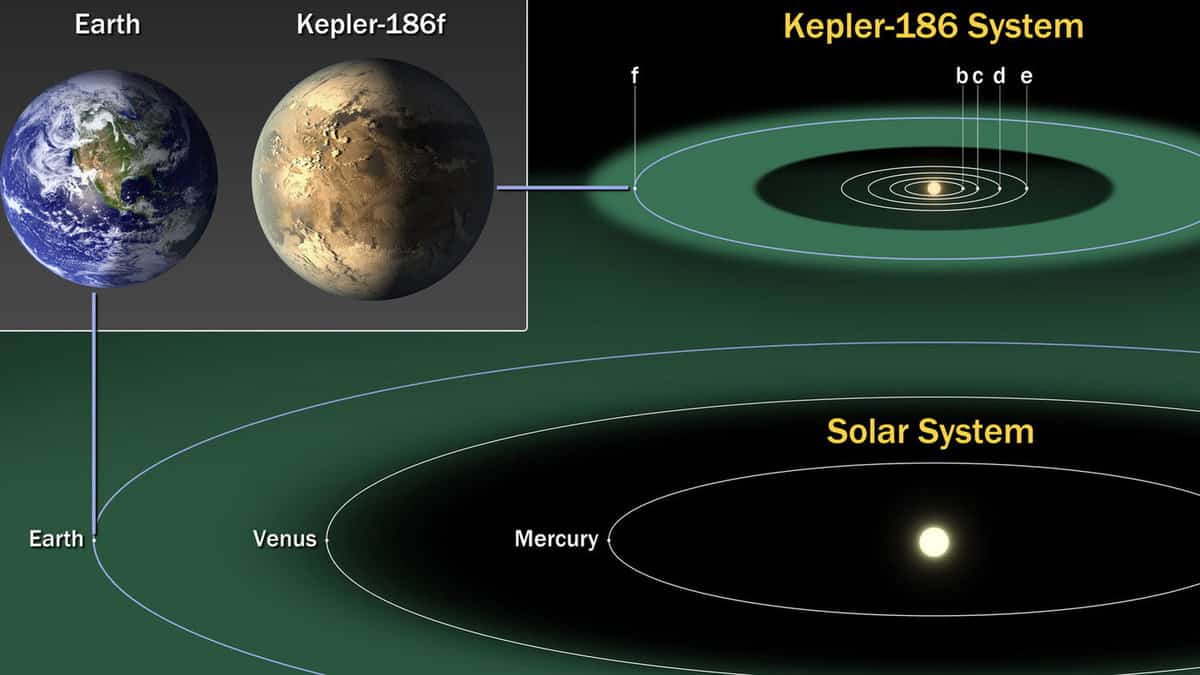The calculation of 500 light years is based on the assumption that light is not influenced by any gravitational fields. This assumption holds true in a vacuum, where the speed of electromagnetic radiation remains constant.
During the 17th century, scientists were engaged in the quest to determine the velocity of light. Prior to this, astronomers had assumed that light rays traveled instantaneously through space. However, this notion was challenged by Galileo Galilei, who sought to calculate the time it takes for a beam of light to travel a specific distance of eight kilometers. Unfortunately, his experiments proved unsuccessful. Likewise, Danish scientist O. Rømer’s investigations also yielded no definitive results. Rømer observed a temporal discrepancy in the eclipses of other planets’ satellites, which seemed to be dependent on the Earth’s position. When the Earth was farther away from another celestial object, it would take longer for the light rays to reach the Earth’s surface. However, Rømer was unable to precisely calculate the speed of light.
In the 18th century, the Englishman James Bradley made a groundbreaking discovery by approximating the speed of light. This esteemed astronomer estimated its velocity to be around 301,000 km/s. Fast forward to the last century, where scientists, armed with Maxwell’s theory of electromagnetism, were able to precisely calculate the speed of light. This remarkable feat was accomplished using cutting-edge laser technologies and taking into account their refraction coefficients. Through meticulous research, the calculated speed of light was determined to be 299,792 kilometers 458 meters per second. This invaluable knowledge paved the way for establishing a convenient unit of measurement for exploring the vastness of outer space.
What is the equivalent of 1 light-year in kilometers
To make the calculation, we based it on 365 days. If we convert the daily value to seconds, we get 86,400 seconds. And if we multiply that by the total number of days, which is 31,557,600, we get the final result.
We have determined the distance that a beam of light travels in one second. By multiplying that by 31,557,600, we find that it is slightly over 9.4 trillion. This is the distance that is considered one light-year when measured in kilometers. It represents the distance that a beam of light would travel in a vacuum over the course of 365 days. It is the distance that the light beam would cover if it traveled along the Earth’s orbit without being influenced by gravitational fields.
Here are some examples of distances calculated using this method:
- A ray of light can travel from the Earth to the Moon in 1 minute and 3 seconds;
- By using this method, we can determine the diameter of our galactic disk in 100,000 years;
- The distance from the Sun to Pluto in light hours is 5.25 hours;
- It would take 2,500,000 light-years to reach the Andromeda Galaxy from Earth, while the star Proxima Centauri is only 4 light-years away;
- It takes 8.20 minutes for sunlight to reach our planet;
- The Center of our Galaxy is located 26,000 light years away from the Sun;
- The Virgo cluster is situated 58,000,000 light years away from our planet;
- Clusters of galaxies can have diameters of tens of millions of light years.
Why is it significant?
By determining the speed of light, astronomers have been able to calculate the distances between planets, stars, and galaxies. This discovery has revealed that the light emitted by a star does not instantaneously reach the Earth. When observing celestial bodies in the night sky, we are actually observing the past. For example, if a distant planet exploded hundreds of years ago, scientists would only be able to record it in the present day.
Calculations in this unit of measurement are convenient within our universe. Less commonly used are hours, weeks, or months. When determining the distance to distant space objects, the resulting value will be enormous. Using such values in mathematical calculations becomes challenging and impractical. Scientists have considered this issue and introduced another unit of measurement – parsec – for astronomical calculations involving large distances. Parsec is more suitable for complex mathematical calculations. A parsec is equivalent to three light-years.
The Comparison of Light Years and Earth Years
In our daily lives, we often measure distances: to work, to the nearest store, to another city. We compare different values to appreciate the differences. Many people perceive the concepts of light years and Earth years as similar, if not the same. There is a desire to compare them. However, it is important to first determine what is meant by an Earth year. It can be defined as the distance traveled by our planet in 365 days. With these parameters, one light-year would be equivalent to 63,000 Earth years.
If an Earth year is calculated in terms of days, it is considered a unit of time. On the other hand, a light year represents distance. Therefore, comparing these values would be meaningless. In this case, there is no answer to the question.
Video
This video provides an explanation of the concept of a light year.
If you didn’t find the answer to your question, you can suggest a topic to the authors.
Galactic distance scales
A light-year (sv. yr., ly) is a unit of length used to measure the distance traveled by light in one year.
To be more precise, as defined by the International Astronomical Union (IAU), a light year represents the distance that light can travel in a vacuum without any gravitational effects over the span of one Julian year (which consists of 365.25 standard days or 31,557,600 seconds). This definition is commonly used in popular science publications. In professional literature, parsecs and larger units such as kiloparsecs and megaparsecs are often utilized to express vast distances instead of light-years.
The numerical values are.
- 9,460,730,472,580,800 meters (approximately 9.46 petameters)
- 63,241,077 astronomical units (a. e.)
- 0.306,601 parsecs
Related units
The following units are not commonly used, usually only in popular publications:
- 1 light second = 299,792.458 km (exact)
- 1 light minute ≈ 18 million km
- 1 light hour ≈ 1079 million km
- 1 light day ≈ 26 billion km
- 1 light week ≈ 181 billion km
- 1 light month ≈ 790 billion km
Measuring Distance in Light Years
Light years provide a useful way to describe the vast distances that astronomers work with.
During their exploration of our planet, humans have invented various systems to measure distances over the course of several centuries. Eventually, it was agreed upon to adopt the meter as the universal unit of length, while using kilometers for measuring long distances.
However, as the 20th century approached, a new challenge arose for humanity. The study of the cosmos revealed that the vastness of the Universe is so immense that kilometers alone are inadequate for measurement. While it is still possible to express distances from Earth to the Moon or Mars in familiar units, attempting to determine the distance to the nearest star in kilometers would result in an astronomical number with an unimaginable amount of decimal places.
What does 1 light-year equal to?
The need for a new unit of measurement arose when it became apparent that the vastness of space required a different scale. This is where the concept of a light-year comes in. In just one second, light can travel a staggering 300,000 kilometers. A light-year – is the distance that light can traverse in the span of a single year. To put it in more familiar terms, that’s equivalent to a mind-boggling 9,460,730,472,580.8 kilometers. Clearly, using the concise term “one light-year” is much more practical than having to work with this astronomical number in calculations every time.
Among all the stars that are closest to us, Proxima Centauri stands out, as it is located a mere 4.22 light-years away. Of course, when measured in kilometers, this distance becomes astronomically large. However, everything is relative – considering that the nearest galaxy, Andromeda, is a staggering 2.5 million light-years away from the Milky Way, Proxima Centauri truly appears to be a remarkably close neighbor.
How many Earth years is equal to 1 light year?
There is a common misconception that a light year is a measure of time. However, this is not the case. The term “light year” actually refers to the distance that light travels in one Earth year and has no correlation with the passage of time. Therefore, it is incorrect to equate a light year with a specific number of Earth years.
When it comes to our daily lives, we often need to measure distances. Whether it’s to the nearest supermarket or to a relative’s house in another city, distance plays a significant role. However, when we start talking about the vast cosmic spaces, using familiar units like kilometers becomes highly impractical. The main issue is not just the difficulty in comprehending the enormous values, but also the sheer number of digits involved. Even writing down such a large number of zeros can be a challenge. For instance, the shortest distance between Mars and Earth is approximately 55.7 million kilometers. That’s six zeros! And keep in mind, Mars is considered one of our closest celestial neighbors. So, how can we possibly deal with the cumbersome numbers that arise when measuring distances to even the nearest stars? This is where a concept like a light-year becomes invaluable. But what exactly is a light-year? Let’s delve into it.
The notion of a light-year is intricately tied to relativistic physics, where the intimate relationship and interdependence of space and time were established in the early 20th century as the postulates of Newtonian mechanics crumbled. Before then, distance values served as the larger units of measurement in the system.

The formation of units of measurement was quite simple: each subsequent unit was a collection of smaller units (such as centimeters, meters, kilometers, and so on). However, when it comes to the light year, the distance is connected to time. According to modern science, the speed of light propagation in a vacuum is constant and is considered to be the maximum speed allowed in modern relativistic physics. These principles served as the foundation for the creation of the light year. A light year is defined as the distance that a beam of light travels in one Earth calendar year. In terms of kilometers, this is approximately 9.46*10^15 kilometers. Interestingly, it only takes a photon about 1.3 seconds to reach the Moon, around eight minutes to reach the Sun, but it would take about four light-years to reach the nearest star, Alpha.
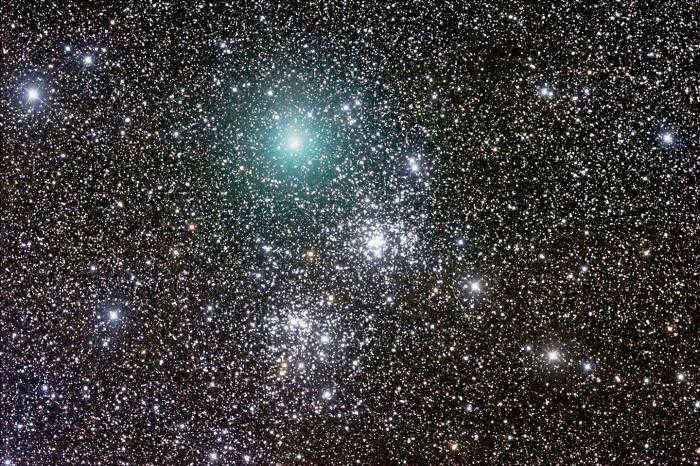
That is an incredible distance. In astrophysics, there exists an even greater quantity of space. A light-year is approximately one-third of a parsec, which is an even more notable measurement unit for interstellar distances.
The velocity at which light travels varies under different circumstances.
By the way, there’s also the aspect that photons can move at different velocities in various surroundings. We’re already familiar with how quickly they travel through a vacuum. And when they mention that a light year corresponds to the distance light covers in a year, they’re referring to empty space. However, it’s worth noting that in other conditions, the speed of light can be reduced. For instance, in the air medium, photons disperse at a marginally slower pace than in a vacuum. The exact rate depends on the specific state of the atmosphere. Therefore, in an environment filled with gas, the value of a light year would be slightly lower. Nevertheless, it wouldn’t deviate significantly from the accepted value.
Astronomers utilize unique units of measurement for their calculations that may not always be readily understood by the general public. This is to be expected, as if cosmic distances were expressed in kilometers, the number of zeros would be overwhelming. As a result, astronomers employ much larger units of measurement, such as the astronomical unit, light year, and parsec, to quantify cosmic distances.
Frequently used to indicate distances within our home solar system, if we can still express it in kilometers (384,000 km), the closest distance to Pluto is approximately 4,250 million km, which may be a bit challenging to grasp. For such vast distances, it is more appropriate to utilize an astronomical unit (a.u.), which equals the average distance from the surface of the Earth to the Sun. In simpler terms, 1 a.u. corresponds to the length of the long semi-major axis of our planet’s orbit around the Sun (150 million kilometers). Thus, if we state that the shortest distance to Pluto is 28 a.u. and the longest journey could be 50 a.u., it becomes much easier to visualize.

Since 1676, scientists have hypothesized that light does not propagate instantaneously, but instead has a certain speed. This theory originated when Ole Remer, a Danish astronomer, observed that eclipses of one of Jupiter’s moons began to lag when the Earth was on the opposite side of the Sun from Jupiter. As the Earth started moving back, the eclipses returned to their previous schedule.
Therefore, a discrepancy of approximately 17 minutes in time was observed. This finding led to the conclusion that it takes exactly 17 minutes for light to traverse a distance equal to the diameter of the Earth’s orbit. Since it has been established that the diameter of the orbit is roughly 186 million miles (or 939,120,000 kilometers), it follows that the speed of light is approximately 186,000 miles per second.
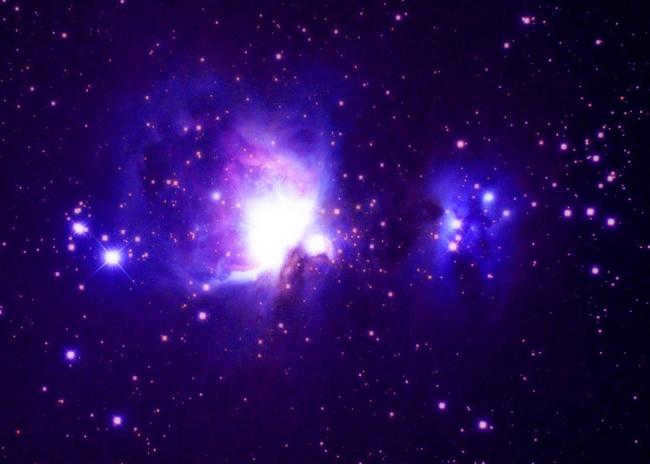
In the present day, with the help of Professor Albert Michelson, who embarked on the task of determining the precise measurement of a light year, a different approach was taken to calculate the final value: 186,284 miles in 1 second (approximately 300 km/s). If we calculate the number of seconds in a year and multiply it by this figure, we find that a light year is equivalent to 5,880,000,000,000,000,000 miles, which is equal to 9,460,730,472,580.8 kilometers.
For practical purposes, astronomers often utilize the parsec as a unit of distance. This unit is defined as the displacement of a star in relation to other celestial bodies by 1 arcsecond when the observer is positioned at a distance of 1 astronomical unit.
So what exactly is a light-year?
How much time does it take for a spaceship from Earth to travel one light-year?
For today’s article, I have decided to explain the significance of this unit of measurement, comparing it to our usual kilometers, and showcasing the vastness of the Universe.
Let’s imagine an individual who, against all rules, is driving on a highway at a speed of 250 km/h. In just two hours, they will cover a distance of 500 kilometers, and in four hours, they will reach a total of 1000 kilometers. That is, of course, if they don’t crash during the process…
You might think that’s fast! However, if this person were to circumnavigate the globe (approximately 40,000 km), they would need 40 times more time. That would be a total of 4 x 40 = 160 hours. In other words, nearly an entire week of continuous driving!
In the end, however, we won’t say that he covered a distance of 40,000,000 meters. Because our laziness has always led us to come up with and use shorter alternative units of measurement.
Everyone should be aware from their high school physics class that the fastest traveler in the entire universe in the entire universe is light. In just one second, its beam can travel approximately 300,000 kilometers, which means it can go around the Earth in only 0.134 seconds. That’s a whopping 4,298,507 times faster than our virtual racer!
It takes an average of 1.25 seconds for light to travel from Earth to the moon. And it takes a little over eight minutes for light to reach the Sun.
Isn’t that incredible? However, there is still no proof of the existence of speeds greater than the speed of light. Therefore, scientists have decided that it would be logical to measure cosmic distances in units that are based on the time it takes for radio waves to travel (which includes light).
So, a light-year is simply the distance that light travels in one year. When dealing with interstellar distances, it doesn’t make much sense to use smaller units. Nevertheless, there are a few smaller units that can be used. Here are their approximate values:
1 light second ≈ 300,000 kilometers;
1 light minute ≈ 18,000,000 km;
1 light hour ≈ 1,080,000,000,000 km;
1 light day ≈ 26,000,000,000,000,000 km;
1 light week ≈ 181,000,000,000,000 km;
1 light month ≈ 790,000,000,000,000,000 km.
And now, to provide you with an understanding of the source of the figures, let’s compute the equivalent of one light year, which is a measure of distance.
There are 365 days in a year, 24 hours in a day, 60 minutes in an hour, and 60 seconds in a minute. Therefore, a year is composed of 365 x 24 x 60 x 60 x 60 = 31,536,000 seconds. In a single second, light travels 300,000 kilometers. Consequently, within a year, the beam of light will traverse a distance of 31,536,000 x 300,000 = 9,460,800,000,000,000 km.
This numerical value can be expressed as: TWENTY TRILLION, FOUR HUNDRED SIXTY SIXTY MILLION MILLIONS, and EIGHT HUNDRED MILLION kilometers.
Undoubtedly, the precise value of the light-year differs slightly from our calculations. However, when discussing distances to stars in popular science articles, utmost accuracy is not necessarily required, and a variation of a hundred or two million kilometers will not significantly impact the overall understanding.
Now, let us proceed with our thought experiments…
Imagine a modern spaceship departing the solar system at a velocity equivalent to the third cosmic velocity (approximately 16.7 km/s). It would take around 18,000 years to travel the first light-year!
As for Alpha Centauri, our nearest star system situated 4.36 light-years away (refer to the image above), the spaceship would require approximately 78,000 years to reach it!
Consider our vast Milky Way galaxy spanning approximately 100,000 light years. To traverse its entire expanse, the spaceship would need a staggering 1 billion, 780 million years!
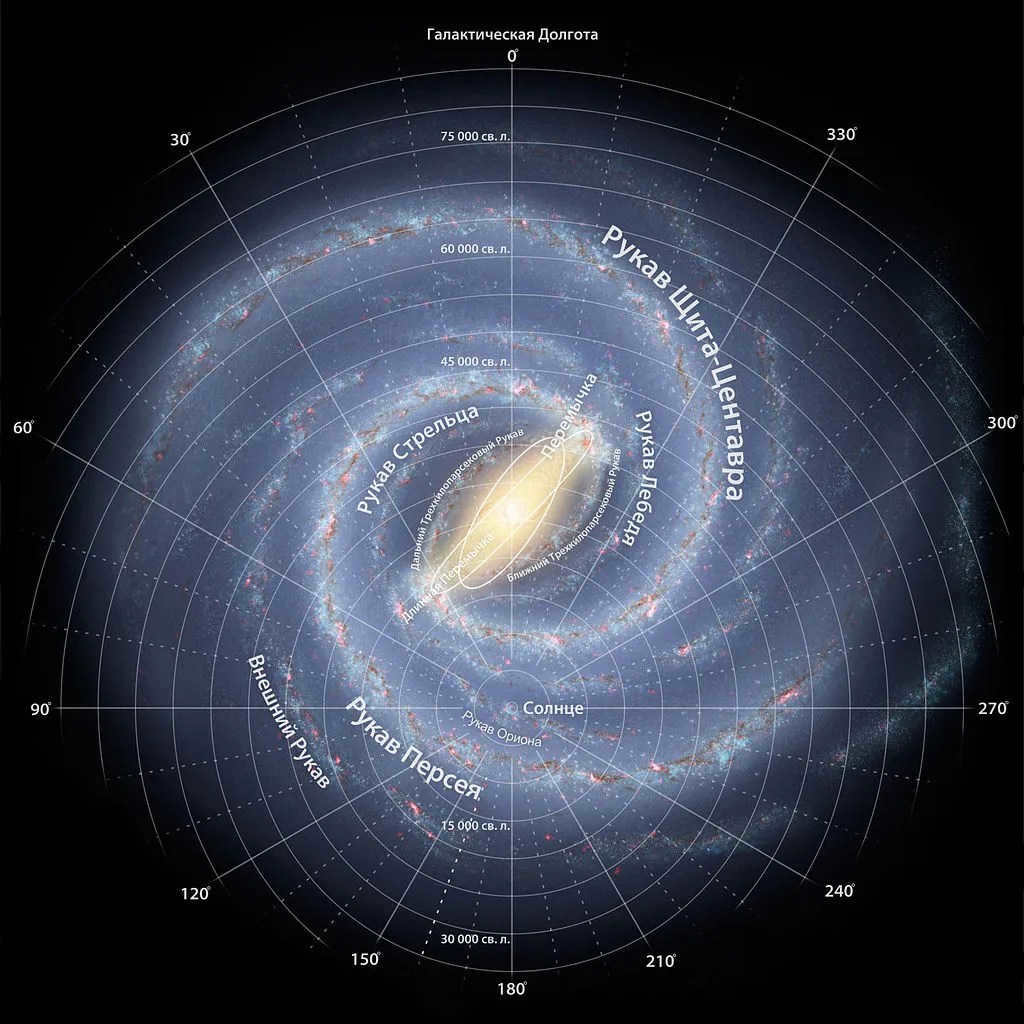
On February 22, 2017, NASA announced the discovery of 7 exoplanets orbiting the star TRAPPIST-1. Among these planets, three are located within the habitable zone, where liquid water could exist and potentially support life. The star system is situated approximately 40 light years away from Earth, which is an immense distance.
This news caused quite a stir in the media, with some speculating that humanity is on the verge of establishing new settlements on these distant planets. However, it is important to note that 40 light years is an incredibly vast distance, making interstellar travel currently unfeasible.
From the physics course, we are aware of the third cosmic velocity – this refers to the velocity that a body in close proximity to the Earth’s surface must possess in order to venture beyond the solar system. The magnitude of this velocity is 16.65 km/sec. Traditional orbital spacecrafts are launched at 7.9 km/sec and orbit the Earth. In theory, a velocity of 16-20 km/sec is quite attainable with modern Earth technologies, but nothing more!
Humanity has yet to master the art of accelerating spaceships beyond the speed of 20 km/sec.
Let’s calculate the number of years it would take for a starship traveling at 20 km/sec to cover a distance of 40 light-years and arrive at the TRAPPIST-1 star.
One light-year represents the distance traveled by a beam of light in a vacuum, and the speed of light is approximately 300 thousand km/sec.
A spacecraft constructed by humans travels at a velocity of 20 km/sec, which is 15000 times slower than the speed of light. Such a ship would take 600,000 years to traverse a distance of 40 light years!
At the current level of technology, it would take an Earth-bound spacecraft approximately 600,000 years to reach the star TRAPPIST-1! According to scientists, the existence of modern humans on Earth spans only 35-40 thousand years, so it would take a staggering 600,000 years to reach our destination!
Even the closest stars remain out of reach for humans, let alone the stars within our own galaxy or other galaxies.
Our Milky Way galaxy spans approximately 100,000 light-years, meaning it would take a modern Earth ship 1.5 billion years to travel from one end to the other! According to scientific estimates, our Earth is 4.5 billion years old, and multicellular life has existed for around 2 billion years. The distance to our nearest galaxy, the Andromeda Nebula, is a staggering 2.5 million light years away from Earth.
As you can see, no person alive today will ever have the opportunity to set foot on a planet orbiting another star.
Over the course of centuries, humans have continually developed new systems for measuring distances as they explore their own planet. This led to the establishment of the meter as the universal unit of length, with kilometers being used to measure longer distances.
However, in the twentieth century, a new challenge arose for humanity. With a closer study of the cosmos, it became apparent that the vastness of the Universe is so immense that kilometers are no longer suitable. While it is still possible to express the distance from Earth to the Moon or from Earth to Mars in familiar units, attempting to determine the number of kilometers to the nearest star results in an unimaginable decimal expansion.
What is the equivalent of 1 light-year?
It became apparent that a new unit of measurement was necessary for the exploration of space – and thus, the light-year was established. In a single second, light is able to travel a distance of 300,000 kilometers. A light-year – represents the exact distance covered by light within the span of one year – and in more conventional terms, this distance amounts to 9,460,730,472,580.8 kilometers. Clearly, it is much more convenient to refer to this vast distance as “one light-year” rather than using the cumbersome figure in every calculation.
Proxima Centauri, which is a mere 4.22 light-years away, stands out among the stars closest to us. Although this distance seems immense in terms of kilometers, it’s all relative. Consider the fact that the nearest galaxy, Andromeda, is a staggering 2.5 million light-years away from the Milky Way. In comparison, Proxima Centauri truly becomes a remarkably close neighbor.
How many Earth years are equal to one light year?
There is a common misunderstanding that the light-year is a measure of time. However, this is not true. The term light-year does not refer to Earth years and does not have any connection to them. Instead, it solely represents the distance that light travels in the span of one Earth year.
While exploring their planet, humans required various measurements of distances and segments. Initially, the measurements of length were imprecise as different civilizations had their own methods of measuring. It was not until 1791 that French scientists introduced a measurement that is still used today – the meter (derived from the Greek word “measure”).
However, in the early 20th century, people started directing their attention towards studying the cosmos. They soon discovered that the universe consists of astronomical distances that could not be adequately measured using the existing metric system. While it is possible to measure the distance from our planet to the Moon or Mars in kilometers, when it comes to measuring distances to other planets or even stars, the numbers become incredibly large, filled with numerous zeros.
Hence, scientists decided to introduce the term “light years” to describe these vast distances.
What is the distance covered by light in a year?
Within a single second, photons of light can travel a distance of 300,000 kilometers. A light year represents the distance that light can cover within a span of 12 months. In terms of kilometers, this distance amounts to approximately 9,460,730,472,580.8 kilometers, which is roughly equal to 9.46 x 10^15 kilometers.
Utilizing the term “light years” proves to be more convenient than dealing with such immense figures expressed in kilometers. However, there are also approximate values that can be used:
1 light second is approximately equal to 300,000 kilometers.
1 light minute is approximately equal to 18 million kilometers.
1 light hour is approximately equal to 1,080,000,000,000 kilometers.
1 light day is approximately equal to 26,000,000,000,000,000 kilometers.
1 light week is approximately equal to 181,000,000,000,000 kilometers.
1 light month is approximately equal to 790,000,000,000,000,000 kilometers.
What is considered excessive?
Assuming the spaceship is traveling at the speed of light (about 16.8 kilometers per second), it would take approximately 18,000 years to travel one light year. Considering that our galaxy, the Milky Way, has a diameter of about a hundred thousand light years, it would take the ship nearly 2 billion years to reach the other side!
The star closest to our Sun is Proxima Centauri, which is approximately four light years away. If we were to convert that distance to kilometers, we would be left with an astronomically large number.
However, when comparing the distance between Proxima Centauri and the nearest galaxy, the Andromeda Nebula, the star suddenly seems much closer. This is because Andromeda is a staggering two and a half million light years away from the Milky Way. It would take a spacecraft approximately 35 billion years to reach its destination.
Utilizing light years aids in comprehending where in the cosmos we may seek out intelligent civilizations. This is how scientists ascertain the viable destinations for transmitting radio signals and those that are not.
Here’s how it functions: the velocity of light is equivalent to the velocity of a radio signal, and it turns out that transmitting messages to locations that will be reached in thousands or even billions of years is absolutely futile. It is logical to search for “neighbors” through a dispatched signal that will voyage for at least one human lifespan.
Enormous cosmic expanses are exceedingly challenging to quantify in kilometers or miles. Scientists have contemplated discovering alternative units of measurement for vast distances. Devotees of science fiction movies and literature frequently encounter the term “light-year”. However, not everyone can explicate the significance of these terms. Some fail to discern its disparity from conventional terrestrial measurements.
The light-year is a widely used unit of measurement for cosmic distances. It is employed in determining:
An essential condition for this calculation is the exclusion of any gravitational fields’ influence on light. This prerequisite is met in a vacuum, where the speed of propagation for all electromagnetic rays remains constant.
In the 17th century, scientists embarked on a quest to determine the velocity of light. Previously, astronomers had assumed that light rays propagated through space instantaneously. However, this notion was challenged by Galileo Galilei, who sought to calculate the time it took for a light beam to traverse a distance of eight kilometers. Unfortunately, his experiments proved unsuccessful. Similarly, the research conducted by Danish scientist O. Rømer also yielded no definitive results. Rømer observed a temporal discrepancy in the eclipses of satellites orbiting other planets, depending on the Earth’s position. When the Earth was farther away from the celestial body, it took longer for the light rays to reach the Earth’s surface. Despite these observations, Rømer was unable to accurately calculate the speed of light.
Englishman James Bradley was the first to approximately calculate the speed of light in the XVIII century. He determined its value to be 301,000 km/s. In the subsequent century, scientists were able to accurately calculate the velocity of light using Maxwell’s theory of electromagnetism. This research utilized advanced laser technologies and considered the refraction coefficients involved. The calculated speed of light was found to be 299,792 kilometers and 458 meters per second. This discovery played a crucial role in establishing a convenient unit of measurement for outer space.
The calculation was based on 365 days. If you convert the daily value into seconds, you will get 86,400 seconds. And in all the given days, their total will be 31,557,600.
We have computed the distance covered by a ray of light in one second. By multiplying that by 31,557,600, we obtain slightly over 9.4 trillion. This represents a light year measured in kilometers. It signifies the distance that a beam of light would travel in 365 days in a vacuum. This is the distance it would cover while moving along the Earth’s orbit without the influence of gravitational fields.
Here are some examples of distances calculated using this method:
- A ray of light can travel from the Earth to the Moon in 1 minute and 3 seconds;
- By using this method, we can determine the diameter of our galactic disk in 100,000 years;
- The distance from the Sun to Pluto in light hours is 5.25 hours;
- It would take 2,500,000 light-years to reach the Andromeda Galaxy from Earth, while the star Proxima Centauri is only 4 light-years away;
- It takes approximately 8.20 minutes for sunlight to reach our planet;
- The Center of our Galaxy is located 26,000 light years away from the Sun;
- The Virgo cluster is approximately 58,000,000 light years away from our planet;
- Clusters of galaxies can measure tens of millions of light years in diameter.
- The measured distance from Earth to the edge of the visible Universe was recorded as 45 billion light years.
Why is it significant?
The speed of light calculation has allowed astronomers to determine the distances between planets, stars, and galaxies. This discovery revealed that the light emitted by a star takes time to reach Earth. When we observe objects in the sky, we are actually seeing the past. For example, a distant planet’s explosion that occurred hundreds of years ago would only be observed by scientists today.
Calculations in this unit of measurement are convenient within our universe. Less commonly used are hours, weeks, or months. When determining the distance to distant celestial bodies, the resulting value will be enormous. Using such values in mathematical calculations becomes difficult and impractical. Scientists have considered this and use another unit of measurement – parsec – for astronomical calculations involving large distances. It is more suitable for complex mathematical calculations. A parsec is equivalent to three light-years.
In our daily lives, we often find ourselves measuring distances: from our home to work, to the nearest store, or even to another city. Comparing different quantities helps us appreciate the differences. The concepts of light years and Earth years may seem similar, if not the same, to many people. There is a natural desire to compare them, but first, we must determine what we mean by an Earth year. We can define it as the distance traveled by our planet in 365 days. Using these parameters, one light year would be equivalent to 63 thousand Earth years.
If we calculate the Earth year in terms of days, it becomes a unit of time. On the other hand, the light year represents a measure of distance. Therefore, comparing these values becomes meaningless. In this case, there is no definitive answer to the question.
Video
Check out this video to gain a clear understanding of the concept of a light year.
If you still have unanswered questions, feel free to suggest a topic to the authors for future videos.

Current Location: » The Omega Astroforum has been closed! » Club » How many Earth years are in one light year?
Posts on Page 1 of 10
Share12014-11-03 20:24:39
- Author: Nyaf
- Moderator
- Awards:
- Registered : 2012-01-08
- Posts: 754
- Last visit:
2016-10-17 23:08:31
How many Earth years are in one light year?
A light year is the distance that light travels in the span of one year:
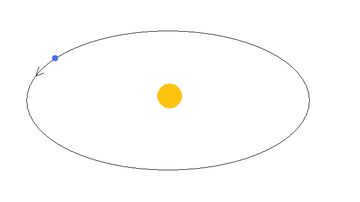
One Earth year represents the distance traveled by the Earth in a span of 365 days:
Let’s equip our runners with timepieces, have them run in a linear trajectory, and examine their outcomes. 
They perform admirably.
Over the course of one year (365 days), a runner named Light covered approximately 9,460,080,000,000,000 kilometers. (at a velocity of 300,000 kilometers per second)
Meanwhile, a runner known as Earth traverses about 946,080,000,000 kilometers within a single year. (at a rate of 30 kilometers per second)
By dividing the former by the latter, we obtain 10 000
That’s roughly the number of years it would take for Earth to catch up to Light, assuming they continue running in a straight line.

Share22014-11-08 19:03:09
- Author: Nyaf
- Moderator
- Awards:
- Registered : 2012-01-08
- Posts: 754
- Last visit:
2016-10-17 23:08:31
In the event of the Sun’s explosion, how much time will pass before the information reaches people?
The distance between the Sun and Earth is approximately 150,000,000 km, and the speed of light is 300,000 km/s, so it would take about 500 seconds, or 8.3 minutes.
If a star explodes in a nearby galaxy, how much time will pass before the information reaches people?
Certainly more than 8.3 minutes from now.
The galaxy M82 is located 12 million light-years away, and astronomers discovered a supernova eruption there this year.
When did it happen? 8 minutes ago? 800 minutes ago? Or even earlier?
If you utilize my illustrated scheme, you will obtain 12 million multiplied by 10,000, which equals 120 billion Earth years.
Anyone who obtains different outcomes is encouraged to share them.
Share32014-11-10 04:33:07
- Author: nyaf
- Moderator
- Awards:
- Registered : 2012-01-08
- Posts: 754
- Last Visit:
2016-10-17 23:08:31
One of the members sent me a message saying that the star exploded 12 million years ago.
That’s an exceptionally accurate response! Logically, it is the immediate subsequent answer.
Therefore, after examining various examples, we have reached the conclusion that a light year is equivalent to a terrestrial year!
Share42014-11-10 20:03:13
- By: konst
- Participant
- Posted on: 2014-11-10
- Total Posts: 2
- Last Visit:
2014-11-14 23:49:33
And also – keep in mind that a light year is a measurement of distance, while an Earth year represents a unit of time. Therefore, the way the question is presented is fundamentally incorrect and resembles asking “how many Newtons are in horsepower?”. Let’s imagine we introduce a new unit of distance called “ZEMNOY GOD” (Z.G.) – I spelled it that way to avoid confusion with terms that are spelled similarly but have different meanings. In the first post, we would use Z.G. exclusively, and in the second post, we would use the Earth year (365 days or approximately 31,536,000 seconds). In this case, the correct calculation would be: t=V/S, where V=c=the speed of light, and S represents the distance. If the distance is measured in light years and the speed of light is measured in light years per year (which is defined as 1), then the resulting time would be 12 million years. However, if we were to perform the calculation using the unit “ZEMNOY GOD”, both the distance to M82 and the speed of light would need to be recalculated. Nevertheless, this would still be meaningless since Z.G. is a unit of distance, not time, and it would only lead to a reduction in value.
Share52014-11-11 16:12:19
- Author: nyaf
- Moderator
- Awards:
- Posted : 2012-01-08
- Posts: 754
- Last visit:
2016-10-17 23:08:31
Hello konst. Thank you for joining Omega Astroforum. I hope you have a great time interacting with our community!
Share62014-11-11 20:32:02
- Author: konst
- Participant
- Posted : 2014-11-10
- Posts: 2
- Last visit:
2014-11-14 23:49:33
The question is really difficult and somewhat of a dead end.
It’s referred to as an “incorrect” or, in everyday language, a meaningless question.
It turns out that the process of observing distant objects is directly proportional to time.
I don’t understand. If you meant “the duration of the observation process [. ] is proportional to time” (by the way, time of what?) – then it becomes trivial.
To discover the current events in M82, one must make a tremendous leap across space.
If individuals were capable of accomplishing this, they would be transported back in time, 12 million years ago, but not on Earth, rather on the opposite side of the cosmos.
No, why would we do that? We can simply obtain information about the present (conditions) much earlier. Without a 12 million year delay. However, there is a risk of becoming entangled in the complexities of space-time operations and the principle of causality.
The question remains: is it possible for us to journey back to our own past, such as the era of the dinosaurs?
Is it possible for an effect to come before a cause? The answer is no, both in terms of definition and in terms of physics. However, it is possible to obtain information about events that happened in the past. For instance, if there were any explosions near M82, and we were close enough with powerful telescopes, we would be able to witness our own past from 12 million years ago. Alternatively, we can imagine a thought experiment where mastodons from the Miocene era invented a video camera and a long-lasting medium that has been preserved for 12 million years and then discovered by us. In this scenario, we would be able to observe the same events, and maybe even more (including sound!).
Share72015-08-30 06:57:06
- Author: Nyaf
- Moderator
- Awards:
- Registered : 2012-01-08
- Messages: 754
- Last Visit:
2016-10-17 23:08:31
Prof. V.S.Yurkovsky has requested that I broaden the topic a bit.

Currently, researchers around the globe are engaged in studying superluminal velocities. Specifically, they are intrigued by the exploration of what occurs to matter and time when surpassing the speed of light.
From my understanding, our lives operate at the rapid pace of light. Light surrounds us everywhere, at work, in the field, in outer space. Without light, we would be unable to see anything and our existence as a species would be impossible. Our perception (awareness) of reality also fluctuates at the frequency of the speed of light. Even though distant stars may have vanished long ago, we still observe them in the dark sky because our perception fluctuates at the speed of light. However, as soon as we manage to surpass the speed of light, even if it’s only for a moment, whether it be mentally, in a dream, through a telescope, or on a spaceship, new realms of knowledge immediately unfold before us.
The camera developed by the Massachusetts Institute of Technology is capable of capturing up to one trillion frames per second, enabling it to record the rapid propagation of a flash of light.
http://24gadget.ru/1161048056-izobreten … video.html
Prior to 2011, this notion seemed like a fairy tale or something out of science fiction. However, it is now a reality that brings a smile to my face.
I hope that everyone can appreciate the significance of this incredible speed.
Share82015-08-30 08:58:32
- Author: nyaf
- Moderator
- Awards:
- Registered : 2012-01-08
- Posts: 754
- Last Visit:
2016-10-17 23:08:31
Being an enthusiast of exploring consciousness, I recall a time when I managed to seize a few minutes of foresight.
It happened years ago when I was in a relationship with a girl that wasn’t quite working out.
Then one afternoon, I attempted to engage her in conversation, but she appeared disinterested and gave me a sidelong glance. Without thinking, I blurted out that a young man would come in and greet us with “good evening”.
“Well, I’ve said something foolish,” she likely thought as she turned away from me.
A few minutes later, a salesman entered the scene and said, “Good evening, I offer. Oh, good afternoon! I offer your attention…”
The girl’s expression changed, she scrutinized me, smiled, and I smiled back… and that was the end of it.
Ultimately, our relationship didn’t work out. She chose to go in a completely different direction, focusing on other people and different values. As a parting gift, I gave her a large pink elephant. After that, we lost touch and went our separate ways. She moved forward with her life, while I continued my “experiments on realization.”
Life continued on its leisurely pace, and every now and then, when I heard Danko’s song “Baby” on the radio or TV, I would inexplicably think of her. I didn’t dwell on the reasons why. It wasn’t until a few years later that I learned she had broken up with her boyfriend and decided to raise their baby on her own.
At that moment, I understood why she made the choice she did.
In general, there have been numerous fascinating instances in life where, due to one circumstance or another, I have managed to witness something intriguing or make accurate predictions.
As I have come to realize, even without any prior knowledge or assistance, one can stay ahead of time. Whether it be by an hour, a day, or for however long one desires. It is possible to grasp such distances that are unheard of by others.
One could delve into a separate discussion on the subject of awareness. It is an extensive and captivating topic. In my opinion, the significant question arises regarding what holds more power: human consciousness or technology. In a heightened state of awareness, certain individuals can perform extraordinary feats that technology, regardless of its strength, cannot replicate.
I have briefly touched upon the concepts of awareness and frequency in this particular discourse. It is indeed a profound and expansive subject.
Share92015-09-01 07:51:13
- Author: Yurkovsky
- Participant
- Posted : 2014-11-05
- Posts: 34
- Gender: Male
- Last visit:
2017-05-07 20:06:57
Nyaf
Thank you so much, dear colleague, for bringing back one of the most fascinating topics! And for sharing the links, of course.
I also found your statement quite remarkable:
Our perception (awareness) of reality fluctuates at the same frequency as the speed of light.
I would like to start by exploring this particular point. However, I want to approach it from a purely materialistic and “mechanical” standpoint. Our lives unfold at the speed of light because all the events (changes) that we perceive (i.e., gather information about) are the result of light reflecting off objects and reaching our visual cortex. The superfast camera in the video clip you mentioned perfectly illustrates this. Now, let’s imagine what would happen if we were to reach the speed of light. Let’s set aside any relativistic viewpoints for now (to avoid any confusion) and imagine time as a movie reel that captures the progression of events. At speeds below the speed of light, we see a “normal” movie where the frames change so quickly that our eyes (and our brains) can’t keep up with the changes. But if we were to accelerate to the speed of the film, we would get stuck on the same frame. What would this mean in a real-life scenario? It would mean that time has stopped! We wouldn’t be able to see the next frame (since it wouldn’t be able to catch up to us), and we wouldn’t be able to see the previous frame (since we wouldn’t be able to go back to it). So much for “warping the space-time continuum.” What happens if we surpass time? Let’s try running the movie reel at a slower speed than our own. A “reverse movie”? Alright, let’s assume that’s the case and let’s run the same “movie” at different speeds:
1) Normal speed. A glass falls off a table and shatters. The mechanism: first, light reflects off the entire glass, then sequentially off each point in space where the glass is located during its fall, and finally off each individual shard. The shards are at rest.
2) The speed of light. The observer moves at the same speed as the quanta of light reflected from the glass at a specific moment. If that moment was when the glass was still on the table, then for us (!) it would never shatter. If it was during the fall, it would “hang in the air” and never fall for us (!). If it was after it broke, we would only see fragments and wouldn’t even realize that it was once a glass.
3) FTL. And this is where things get interesting. The quanta of light reflected off the whole glass at rest travel farther than those reflected off a falling glass, and even farther than those reflected off a broken one. Therefore, in theory, we could catch up to and overtake these quanta, but in a “back to front” manner. By the way, this phenomenon is vividly described by Soviet science fiction writer Alexander Belyaev in his story “Svetopredstavlenie” (I highly recommend it to everyone!). However, both in the story’s plot and in our case with the glass, there are established facts: “a whole glass” – “a falling glass” – “a broken glass.” Therefore, even if we were to surpass the speed of light, we still wouldn’t be able to surpass time and “see into the future,” but we would only be able to return to the past. And even that would be an illusion, because by the time we see the whole glass, it would already be broken as a fact.
From the above, we can draw the following conclusion:
Light and time are not the same, and by “defeating” one phenomenon, we cannot simultaneously alter the other.
This statement is what I would like to bring up for general discussion.
Edited by Yurkovsky (2015-09-01 07:53:10)
Share102015-09-02 00:23:06
- Author: nyaf
- Moderator
- Awards:
- Registered : 2012-01-08
- Posts: 754
- Last visit:
2016-10-17 23:08:31
If I had the power to alter the past, I would choose not to interfere. I believe that both the positive and negative experiences should remain in the past. What has happened, has happened. I have no desire to change anything. However, I might be inclined to change my own future, rather than affecting the future of everyone. In my viewpoint, the Russian people are facing a grim fate. There is an abundance of deceit, theft, and murder, causing Russia to gradually crumble. The only hope lies in a miraculous intervention or the resurrection of their living Christ. To say the least.
Upon reflection, when one manages to surpass the speed of light, we catch a glimpse of the forthcoming future. In our case, it is depicted as a “shattered glass”. It shatters, soaring through the air, and we witness its slow descent. With a little more anticipation, it shall inevitably fall.
Do you believe that in the past, it was only possible to observe the consequence of shattered glass, but not the actual glass itself? Currently, we are witnessing a glass that is on the verge of falling. For the sake of simplicity, we can refer to it as a falling glass or a broken glass, whichever is more convenient.
As “time travelers,” what are our options in this scenario? Firstly, we can disregard the glass. It is inevitably going to topple, so why bother? Secondly, we can relocate the glass to a safe spot, preventing it from falling. Thirdly, without being aware of our actions, we can instinctively pour tea into the glass, browse the internet, and catch up on the latest news.
And here is the latest development.
While amateur astronomers on astroforums perceive a light year solely as a unit of distance, scientists worldwide are genuinely delving into the study of space and time at high velocities.
Best wishes to everyone for an enjoyable conversation!
Throughout the centuries, humans have been exploring their own planet and developing new systems for measuring distances. As a result, it was unanimously decided to adopt the meter as the universal unit of length, while kilometers were used for longer distances.
However, as the twentieth century approached, a new challenge arose for humanity. People began to delve into the study of the cosmos and discovered that the vastness of the Universe is so immense that kilometers alone are inadequate. While the distance from the Earth to the Moon or Mars can still be expressed in conventional units, attempting to determine the distance in kilometers to the nearest star results in an incomprehensible number of decimal places.
What is the equivalent of 1 light-year?
It became evident that the exploration of outer space necessitated the creation of a new unit of measurement, known as a light year. In a single second, light can travel approximately 300,000 kilometers. A light year – refers to the distance that light can travel in the span of one year – and to put it in more conventional terms, that distance is equivalent to 9,460,730,472,580.8 kilometers. It is clear that using the concise term “one light-year” is much more convenient than having to utilize this immense figure in calculations each time.
Proxima Centauri is the closest star to us, and it is situated at a distance of “only” 4.22 light-years. Of course, when expressed in kilometers, this number is incredibly vast. However, everything is relative – when considering that the nearest galaxy, known as Andromeda, is located a staggering 2.5 million light-years away from the Milky Way, the aforementioned star truly starts to appear as a very close neighbor.
Incidentally, the utilization of light-years assists researchers in determining the regions of the cosmos that are worth exploring for signs of intelligent life, as well as the areas where transmitting radio signals would be utterly futile. This is because the speed of radio signals is comparable to that of light. Therefore, a message sent towards a remote galaxy would only reach its destination after millions of years. It is more sensible to anticipate a response from nearby “neighbors” – celestial bodies whose hypothetical return signals could be detected by Earth’s instruments within a human lifespan.
There is a common misconception that the light year is a measure of time. However, this is not the case. The term “light year” has no relation to Earth years and does not represent a unit of time. Instead, it is a measurement of the distance that light can travel in one Earth year.
As you may be aware, scientists have developed an astronomical unit to measure distances within our solar system, including the distances between planets and from the Sun. But what exactly is a light year?
It is important to clarify that a light year is indeed a unit of measurement used in astronomy. However, it is not a measure of time, despite the word “year” in its name. Instead, it represents a measurement of distance.
What is the equivalent of a light year?
When scientists were able to calculate distances to the closest stars, it became evident that the astronomical unit was not suitable for use in the stellar world. Let’s start by saying that the distance from the Sun to the nearest star is approximately 4.5 light years. This means that it takes 4.5 years for light from our Sun to reach the nearest star, which is called Proxima Centauri, by the way! How vast is this distance? Let’s spare everyone the math and just note that light particles travel at a speed of 300,000 kilometers per second. In other words, if you send a signal from a flashlight to the Moon, the light will be visible there in less than a second and a half. It takes 8.5 minutes for light to travel from the Sun to the Earth. So, how many light rays travel in a year?
Let’s admit it: a light year equals approximately 10 trillion kilometers. (A trillion signifies twelve zeros). More accurately, 9,460,730,472,581 kilometers. If transformed into astronomical units, that would be approximately 67,000. And that is merely to the closest star!
Unquestionably, in the realm of stars and galaxies, the astronomical unit is not appropriate for measurements. It is more convenient to employ light-years in calculations.
Relevance in the celestial realm
Take, for instance, the proximity between Earth and the most luminous star in the sky, Sirius, which spans a distance of 8 light-years. Similarly, the gap from the Sun to Polaris measures approximately 600 light-years, necessitating a 600-year journey for light to traverse the expanse. This distance is equivalent to about 40 million astronomical units. To provide some perspective, it is worth noting that the diameter of our galaxy, the Milky Way, measures around 100,000 light years. Furthermore, our closest neighboring spiral galaxy, known as the Andromeda Nebula, is situated a staggering 2.52 million light years away from our planet. Expressing this distance in terms of astronomical units would be incredibly cumbersome. However, there are entities within the Universe that are located at a staggering distance of 15 billion light years from us. Consequently, the radius of the observable Universe stands at 13.77 billion light years. It is important to acknowledge that the complete expanse of the Universe extends far beyond the observable fraction that we are acquainted with.
Incidentally, the size of the observable Universe is not simply twice the radius, as one might assume. This is due to the expansion of the cosmos over time. Objects that emitted light 13.77 billion years ago have since moved even farther away from us. Currently, they are situated over 46.5 billion light years away. Doubling that value gives us a staggering distance of 93 billion light-years, which represents the true diameter of the observable Universe. Hence, the size of the observed portion of the cosmos, also known as the Metagalaxy, is constantly increasing.
Attempting to measure such vast distances in kilometers or astronomical units is nonsensical. In all honesty, even light-years are not entirely suitable. However, a better alternative has yet to be devised. The resulting numbers are so immense that only computers can handle them.
Therefore, a light year (sv. g.) is a measure of length, not time, representing the distance that a beam of sunlight can travel in one year, which is equivalent to 365 days. . This particular unit of measurement is highly advantageous due to its clarity and enables us to determine how long it would take to receive a response when sending an electromagnetic message to a specific star. However, if this time frame is excessively long (e.g., a thousand years), then it becomes pointless to engage in such actions.
Distances on a galactic scale
A light-year (sv. yr., ly) serves as an extraterrestrial unit of length, representing the distance covered by light within a span of one year.
More precisely, as per the International Astronomical Union’s (IAU) definition, a light year is equivalent to the distance covered by light in a vacuum, unhampered by gravitational fields, within one Julian year (which is defined as 365.25 standard days or 31,557,600 seconds). This is the recommended definition for popular science literature. In professional literature, parsecs and their multiples (such as kiloparsecs and megaparsecs) are typically used to express vast distances, instead of light-years.
Prior to 1984, a light-year denoted the distance traveled by light in one tropical year, specifically assigned to the epoch 1900.0. The new definition deviates from the old one by approximately 0.002%. Since this unit of distance is not utilized for highly precise measurements, there is no practical distinction between the old and new definitions.
Numerical values
- 9,460,730,472,580,800 meters (approximately 9.46 petameters)
- 63,241,077 astronomical units (a. e.)
- 0.306,601 parsecs
Related units
The following units are used rather infrequently, usually only in popular publications:
- 1 light second = 299,792.458 km (exact)
- 1 light minute ≈ 18 million km
- 1 light hour ≈ 1079 million km
- 1 light day ≈ 26 billion km
- 1 light week ≈ 181 billion km
- 1 light month ≈ 790 billion km
Measurement of Distance in Light-Years
The light-year serves as a convenient unit of measurement for representing distances in astronomy.
| Seconds | 4.710 −8 | The average distance to about 380,000 km. This implies that it would take approximately 1.3 seconds for a ray of light emitted from the surface to reach the Moon’s surface. |
| Minutes | 1.610 −5 | One astronomical unit is approximately equal to 150 million kilometers. Hence, it takes around 500 seconds (8 minutes and 20 seconds) for light to reach the Earth. |
| Hours | 0.0006 | The average distance from the Sun to about 5 light hours. |
| 0.0016 | The Pioneer and Voyager spacecrafts have traveled approximately one hundred astronomical units from the Sun in the approximately 30 years since their launch, and their response time to Earth’s requests is approximately 14 hours. | |
| Year | 1.6 | The inner edge of the hypothetical cloud is located 50,000 a. e. from the Sun, while the outer edge is 100,000 a. e. It would take light about a year and a half to travel the distance from the Sun to the outer edge of the cloud. |
| 2.0 | The maximum radius of the region influenced by the Sun’s gravity (the “Hill Sphere”) is about 125,000 a. u. e. | |
| 4.2 | The closest star to us (excluding the Sun), Proxima Centauri, is 4.2 sv. years away. | |
| Millennia | 26,000 | The center of our Galaxy is approximately 26,000 light years from the Sun. |
| 100,000 | The diameter of our disk is 100,000 light years. | |
| Millions of years | 2.510 6 | The closest galaxy to us, M31 (the Andromeda Galaxy), is 2.5 million light years away. |
| 3.1410 6 | M33 (the Triangulum Galaxy) is 3.14 million light-years away and is the farthest stationary object visible to the naked eye. | |
| 5.810 7 | The nearest galaxy cluster, the Virgo cluster, is 58 million light-years away. | |
| Tens of millions of light years | The typical size of galaxy clusters in diameter. | |
| 1.510 8 – 2.510 8 | The gravitational anomaly known as the “Great Attractor” is located at a distance of 150-250 million light years from us. | |
| Billions of years | 1.210 9 | The Sloan Great Wall is one of the largest known structures in the universe, with a size of about 350 Mpc. It would take approximately a billion years for light to travel from one end to the other. |
| 1.410 10 | The size of the causal region of the Universe. Calculated from the age of the Universe and the maximum speed of information transmission, which is the speed of light. | |
| 4.5710 10 | The estimated distance from Earth to the edge of the observable Universe in any direction; the associated radius of the observable Universe (within the standard Lambda-CDM cosmological model). |
This news caused a great deal of buzz in the media, with some even speculating that humanity was on the verge of establishing new colonies on the distant star. However, this is not the case. Forty light years is an immense distance, far too vast for our current technology to traverse.
In our physics classes, we learn about the third cosmic velocity, which is the speed required for an object near the Earth’s surface to escape the solar system. This velocity is approximately 16.65 km/sec. Conventional spacecraft are launched at speeds of around 7.9 km/sec and remain in orbit around the Earth. While speeds of 16-20 km/sec are within the realm of possibility for modern Earth technology, they cannot exceed this limit.
As of now, humanity has not yet developed the capability to propel spaceships at speeds greater than 20 km/sec.
Let’s calculate the number of years it would take for a starship traveling at a speed of 20 km/sec to cover a distance of 40 light-years and reach the star TRAPPIST-1.
One light-year is the distance traveled by a beam of light in a vacuum, and the speed of light is approximately 300 thousand km/sec.
A spacecraft built by humans travels at a speed of 20 km/sec, which is 15,000 times slower than the speed of light. Therefore, it would take this ship 600,000 years to cover a distance of 40 light-years!
An Earth ship (with current technology) would take about 600,000 years to reach the star TRAPPIST-1! It is worth noting that the existence of a reasonable human on Earth (according to scientists) is only 35-40 thousand years, whereas in this case, it would take 600 thousand years!
In the not-too-distant future, advancements in technology will make it possible for mankind to reach the TRAPPIST-1 star system. Although currently non-existent in Earth’s reality, promising engines such as ion propulsion, photon propulsion, and space sails have been estimated to potentially accelerate a spacecraft to a speed of 10,000 km/s. This would significantly reduce the travel time to the TRAPPIST-1 system to just 120 years, which is a relatively acceptable timeframe for either a cryogenic hibernation journey or for multiple generations of settlers. However, it is important to note that these advanced engines are still purely speculative and do not yet exist.
Even the closest stars to our solar system are still incredibly distant for humanity to reach, let alone the stars within our own Milky Way galaxy or other galaxies in the universe.
Our galaxy, the Milky Way, spans approximately 100,000 light-years, meaning that it would take a modern Earth spacecraft 1.5 billion years to travel from one end to the other! According to scientific estimates, our planet Earth is about 4.5 billion years old, while multicellular life has existed for approximately 2 billion years. The Andromeda Nebula, our closest neighboring galaxy, is located a staggering 2.5 million light-years away from us – an incredibly vast distance!
As you can see, out of all the individuals currently alive, none will ever have the opportunity to set foot on a planet orbiting another star.
Undoubtedly, when you hear a phrase like “Tatooine is twenty light years away” in a science fiction action movie, many legitimate questions may arise. Allow me to address some of them:
So, what exactly is a light-year?
And how long would it take a spaceship departing from Earth to travel one light-year?
Today, I have decided to dedicate this article to explaining the significance of this particular unit of measurement, as well as comparing it to the more commonly used kilometers, and showcasing the scales at which it is utilized in the vast expanse of the Universe.
Let’s envision an individual who, in complete disregard for all regulations, is driving on a highway at a staggering speed of 250 km/h. In just two hours, they would cover a distance of 500 kilometers, and in the span of four hours, a whopping 1000 kilometers. That is, of course, if they manage to avoid any mishaps during their reckless endeavor…
You might think that is quite the velocity! However, if this daring driver were to embark on a journey around the entire globe (approximately 40,000 km), they would require a significantly greater amount of time. Specifically, they would need 40 times more time, which equates to 4 multiplied by 40, resulting in a total of 160 hours. In other words, almost an entire week of non-stop driving!
Yet, in the end, we would not express this feat as having covered a distance of 40,000,000 meters. This is due to our inherent laziness, which has consistently driven us to develop and employ shorter alternative units of measurement.
Everyone should be aware from their high school physics classes that the fastest traveler in the entire universe in all of existence is light. In just one second, its beam is able to cover a distance of approximately 300,000 kilometers, allowing it to complete a full orbit around the Earth in a mere 0.134 seconds. That’s a staggering 4,298,507 times faster than our virtual racer!
When it comes to traveling from our planet to the moon, light takes an average of 1.25 seconds to complete the journey. However, when it comes to reaching the sun, it actually takes a little over eight minutes for light to reach its destination.
Isn’t that mind-boggling? And yet, despite its incredible speed, we have not yet discovered any evidence of speeds surpassing that of light. Therefore, the scientific community has determined that it would be logical to measure the vastness of the cosmos using units that are based on the time it takes for certain intervals of radio waves to pass through space (which includes light, of course).
1 light second is approximately equal to 300,000 kilometers;
1 light minute is approximately equal to 18,000,000 km;
1 light hour is approximately equal to 1,080,000,000,000 km;
1 light day is approximately equal to 26,000,000,000,000,000 km;
1 light week is approximately equal to 181,000,000,000,000 km;
1 light month is approximately equal to 790,000,000,000,000,000 km.
And now, to give you an idea of where the numbers come from, let’s calculate what one light year equals a light year.
There are 365 days in a year, 24 hours in a day, 60 minutes in an hour, and 60 seconds in a minute. So a year consists of 365 x 24 x 60 x 60 x 60 = 31,536,000 seconds. In one second, light travels 300,000 kilometers. Hence, in a year, its ray will travel a distance of 31,536,000 x 300,000 = 9,460,800,000,000,000 km.
This number can be expressed as TWENTY TRILLION, FOUR HUNDRED SIXTY-SIX MILLION MILLIONS, and EIGHT HUNDRED MILLION kilometers.
Certainly, the precise value of a light-year slightly deviates from our calculations. However, when explaining distances to stars in popular science articles, absolute accuracy is not crucial, and a variation of a hundred or two million kilometers will not significantly affect the narrative.
Now, let’s proceed with our thought experiments…
Imagine a contemporary spacecraft departing from our solar system at a velocity equivalent to the third cosmic speed (approximately 16.7 km/s). It would take this spacecraft 18,000 years to traverse the initial light-year!
For our nearest star system, Alpha Centauri, which is located 4.36 light-years away (refer to the image at the beginning), the journey would span around 78,000 years!
As for our Milky Way galaxy, which spans roughly 100,000 light years, it would require an astonishing 1 billion, 780 million years to traverse it.

Contents
- How much time does it take for one light-year to pass at the speed of light?
- What can be measured in light years?
- Can the speed of light be exceeded?
- Is it possible to see the past in space?
- How long does it take to travel to the moon and back?
- How do we measure distance in space?
- Who was the first person on Mars?
- How many days are there in a year on Mars?
- What color is a mirror?
- How does time pass in space?
What is the meaning of the term “40 light years”?
Do you understand that this represents an incredibly vast distance? It is equivalent to 180 years of travel.
How far away is the Sun in terms of light years?
The distance from Earth to the Sun is approximately 8 light minutes, which can also be expressed as 0.1333 light hours, 0.005555 light days, or 0.0000152 light years. These are all measurements of distance and cannot be directly translated into units of time (such as hours or minutes).
A light year represents the distance that a beam of light travels in one year, which is equal to 365 days. Considering that the speed of light is nearly 300,000 kilometers per second, this means that a light year is equal to approximately 9,460,800,000,000,000,000 kilometers, or roughly 10 trillion kilometers.
How far can we see in terms of light years?
One light year is approximately equal to 10 trillion kilometers, which represents the distance that light can travel within a span of one year. Proxima Centauri, the closest star to our solar system, is situated at a distance of slightly over four light years away. This means that the light we perceive from Proxima Centauri today actually originated from the star four years ago.
How long would it take to cover a distance of one light year at the speed of light?
The speed of light is approximately 300,000 kilometers per second. Therefore, if Voyager were to travel at this speed, it would take around 17,650 years to cover a distance of one light year.
What is the distance in light years between Earth and Mars?
Scientists have calculated that the average distance between Earth and Mars is approximately 16-17 light years. Mars possesses distinct characteristics compared to other planets, which are primarily attributed to its unique relative position in relation to the Sun. While the other planets orbit the Sun in a counterclockwise direction, Mars follows a clockwise path.
What is the name of the star closest to our solar system?
| Declination | −62° 40′ 46″ |
| Distance | 4.243±0.002 sv. year (1.30091±0.00015 pc) |
| Visible stellar magnitude (V) | 11,05 |
| Constellation | Centauri |
What is the actual color of the Sun?
The Sun is officially classified as a yellow dwarf, with a surface temperature of approximately 6,000 °C, and emits almost white light. However, when viewed from Earth’s surface, the Sun appears to have a more pronounced yellow color due to the scattering and absorption of the short-wave spectrum by our atmosphere, which is also the reason why our sky appears blue.
There are two different units of measurement that are utilized in order to approximate the distances between stars: the light-year and the parsec.
If you were to accelerate to the speed of light, what would occur?
As a result, solely light possesses the ability to travel at the speed of light due to its lack of mass. In conclusion, while traveling at an exceedingly fast velocity can alter your perception of time, it is regrettably impossible to travel through time by surpassing the speed of light.
Can we surpass the speed of light?
The velocity of waves relies on the characteristics of the medium they travel through. As per the special theory of relativity, it is not feasible to accelerate a massive object beyond the speed of light in a vacuum.
Is it possible to observe the past in outer space?
Since it is located 4 light-years away, we can perceive the star as it existed 4 years ago. However, in space, we also have the ability to witness events from the more remote past. The Crab Nebula, for instance, is a residual effect of a supernova explosion that was discovered in the year 1054.
Where is the current destination of Voyager 1?
| Operator | NASA |
| Mission objectives. | Saturn, Jupiter, heliospheric boundaries. |
| Flyby | Saturn, Jupiter |
| Launch pad | Cape Canaveral, SLC-41. |
Is it possible to escape the boundaries of our solar system?
In addition, as our planet Earth moves further away from the Sun, it will gradually cool down until it eventually freezes. The temperatures will plummet to a bone-chilling -230 degrees Celsius. Even if there is some form of life that manages to survive on our planet, it will ultimately face a grim fate. Consequently, the chances of humanity venturing beyond the perils of the solar system seem highly unlikely.
How many years has Voyager 2 been on its interstellar journey?
| Launch pad | Cape Canaveral |
| Launch vehicle | Titan IIIE / Centaurus. |
| Launch | August 20, 1977 14:29:00 UTC |
| Flight duration | 45 years, 9 months, 18 days. |
Is it feasible to embark on a journey to a distant star?
Given the current state of rocket engine technology, it is not currently feasible to undertake a voyage to even the nearest star. Using ion engines operating at their maximum speed of 56,000 km/h, and assuming no obstacles along the way, a journey to Proxima Centauri would take approximately 80,000 years!
How much time does it take to travel to the Moon and back?
| Landing location | Sea of Rains, Hadley Apennines. |
| Flight duration | to the Moon – 78 hours 38 minutes 27 seconds |
| SCN | 05351 |
The Gregorian and Julian calendars have a calendar year of 365 days in non-leap years and 366 days in leap years. The average duration of a year is 365.2425 days for the Gregorian calendar and 365.25 days for the Julian calendar.
For measuring distances between stars, we have a unit called parsec. The name “parsec” is a combination of the words “parallax” and “second”. This unit represents the distance from which the radius of the Earth’s orbit can be observed at an angle of one second of arc.
Is there anything that can move faster than sunlight?
On Friday, September 23, the OPERA collaboration published a paper in the Electronic Preprint Archive regarding their direct measurement of neutrino velocity. The results are quite remarkable: the speed of neutrinos was found to be slightly, but statistically significantly, greater than the speed of light.
How much time would it take to travel to Mars at the speed of light?
If you’re curious about the amount of time it takes for light to travel to Mars, it’s an average of 12 minutes and 40 seconds. Just to put it into perspective, light takes 8 minutes and 19 seconds to reach Earth. And if you’re interested in the distance between the Moon and Mars, it’s approximately 55.7 million km at maximum approximation and 400 million km at maximum approximation.
Looking for flight options from Moscow?
| Israel | Travel to Israel (Tel Aviv, Ben Gurion Airport) | 4 hours 15 min |
| India | Travel to India (Delhi, Indira Gandhi Airport) | 6 hours 10 min |
| Indonesia | Travel to Indonesia (Jakarta, Soekarno Hatta Airport) | from 15 hours |
| Jordan | Travel to Jordan (Amman, Quin Alia airport) | 5 hours |
Who was the first person to set foot on Mars?
In 1971, the descent vehicle of the Soviet AMS Mars-3 became the first to land on Mars. Shortly after touchdown, the Automated Martian Station started transmitting data from the Martian surface. However, the transmission abruptly ceased after only 14.5 seconds.
How long is a year on Mars?
It is highly probable that the Martian year will soon be given its own designated name. The duration of a Martian year is approximately 686.94 Earth days, which is equivalent to 669.56 “sols”. A sol, in turn, lasts for 1,02595675 Earth days.
What is the color of a mirror?
A mirror reflects all colors equally, so it can be considered colorless or white. The reflected light does not take on any specific color. However, it is possible to create a mirror that reflects different colors to different degrees by applying a reflective amalgam to colored glass.
How long is 1 year in space?
One year in space is a measurement of time that spans nearly 14 billion years in terms of the age of the universe. However, in terms of a calendar year on Earth, one year in space is the same duration. In other words, it compresses into one normal year.
Additionally, the length of a day on the International Space Station (ISS) is approximately 90 minutes, due to its orbit around the Earth.
What is the passage of time like in space?
– The passage of time in space is indistinguishable from that on Earth. While orbiting our planet, we complete approximately 14-15 revolutions in a day. Each revolution, lasting about an hour and a half, allows us to witness the transition from day to night and vice versa. Thus, in a single day in space, we experience the occurrence of day and night 14-15 times.
Did our responses provide assistance?
Trending in the past 24 hours

What is the benefit of shooting video in a horizontal orientation?
SHOOT HORIZONTALLY. Filming in a horizontal orientation enables you to capture a larger field of view, in addition to.

When is the optimal time to capture images in an outdoor setting?
Occasionally, it is advisable to delay shooting for an hour or two after midday, allowing the sun to shift slightly for better results.

Which iPhone supports night mode?
Night mode can be used for taking photos on certain iPhone models.


How can I enable HDR on iPhone?
To enable HDR on your iPhone, go to Settings > Camera and disable the Auto-HDR option. You can then turn on the HDR feature directly from the camera screen.

What is the process of capturing photos using the night mode feature on an iPhone?
When the camera senses low light conditions, it activates the night mode automatically. You can identify the night mode by its icon.

Where am I prohibited from taking pictures with my mobile phone?
According to Article 152.1 of the Civil Code of the Russian Federation: “Filming in public places is permitted under certain additional restrictions.”


What is the best way to capture the mesmerizing starry sky using an iPhone 13?
Initially, you can take a photo of the starry sky without any support, but it is advisable to locate a stable surface like a handrail or any other flat object.

What is the method for capturing images of oneself on an iPhone?
Concealed photography using an iPhone with iOS 12. In order to enable covert photography, simply open the camera application.

True Tone technology makes use of a series of multi-channel sensors, which assist the device in its operations.


